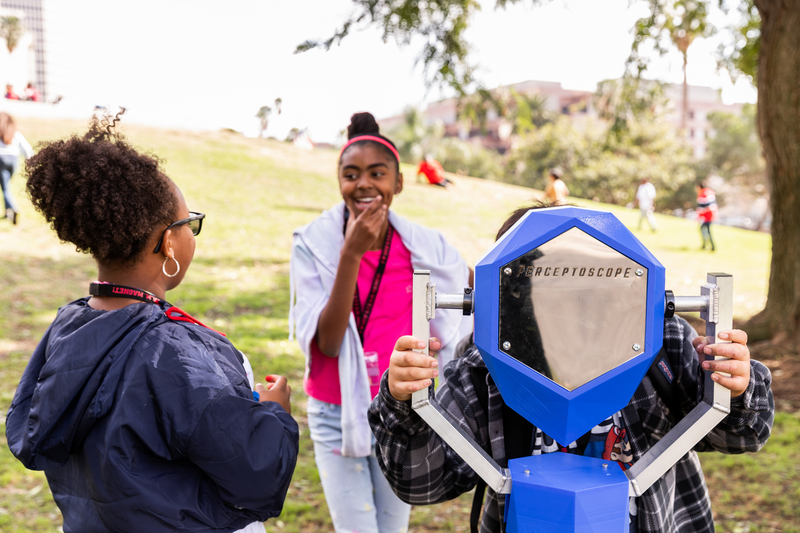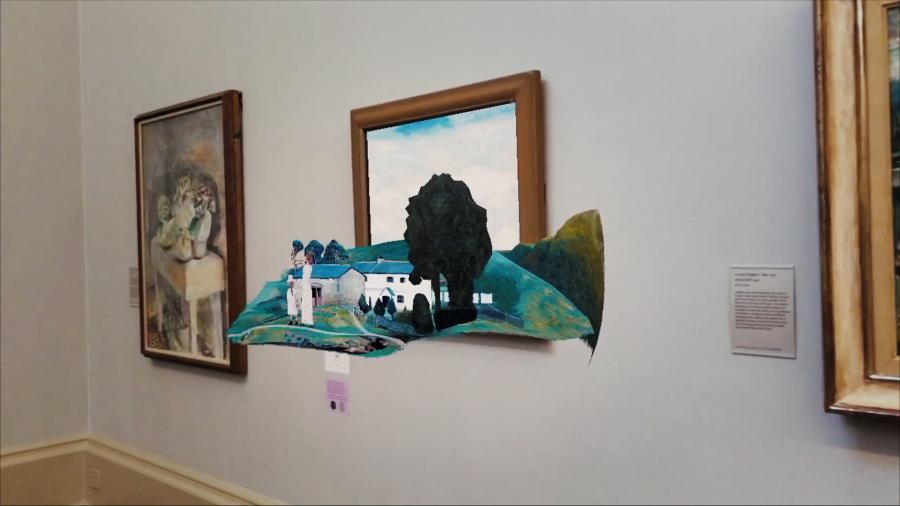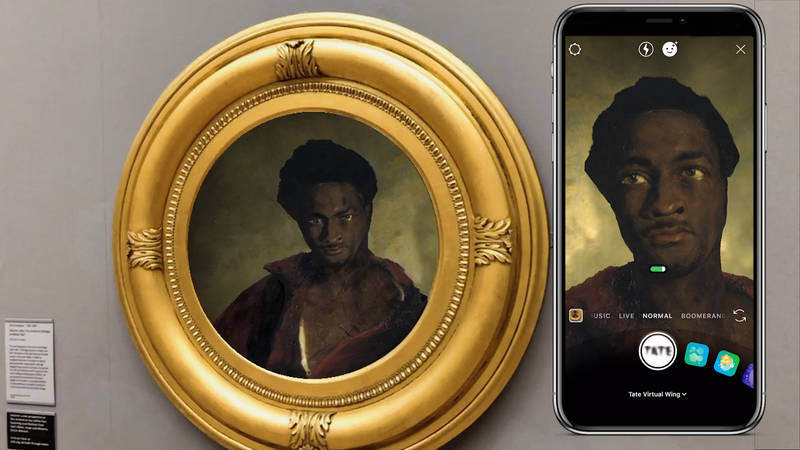New Realities
Attractions are adept at augmenting reality to capture people’s imagination. There are myriad techniques to achieve augmentation, from the classic Pepper’s Ghost illusion to audiovisual and multimedia effects such as projection mapping.
In recent years, guests have come to expect digital devices, including smartphones and headsets, to deliver augmented reality (AR) and open up new worlds for them. The beauty of AR is its ability to supplement the real world, and attractions are continually experimenting with its creative potential.

Revealing Art Secrets
In 2019, Tate Britain collaborated with the Facebook-owned platform Spark AR Studio to create AR filters for the Instagram app. Visitors to the London gallery can hold up their smartphones to discover hidden stories and context behind eight pieces of artwork. AR animations add depth, dimension, and dynamism to the experience.
In John Singer Sargent’s painting, “Carnation, Lily, Lily, Rose,” the light fades and lanterns flicker, only to revive again. John Simpson’s 19th-century portrait, “Head of a Man,” depicting actor Ira Frederick Aldridge, shows the character’s changing gaze and moods.
Facebook believes the potential of contextually relevant AR is huge. “We can help people learn and connect to the world around them in meaningful ways,” says Matthew Roberts, who heads up Spark AR.

New Perspectives on Nature
Brevard Zoo in Florida harnessed AR for its transformed “Rainforest Revealed” exhibit. “As a zoo, our focus is to connect people with nature, which often means making sure people are not on their phones using an app while they visit us. However, we do see a benefit to using AR, especially if the technology enables us to tell more of the story in a cool, visual way,” says Andrea Hill, marketing and communications director at Brevard Zoo.
The zoo chose Falcon’s Creative Group to design and implement a turnkey AR experience. “The goal was to tell the story of how pacu fish play a vital role in sustaining and replenishing the Amazon rainforest during seasonal floods,” says Jason Ambler, vice president of digital media and executive producer at Falcon’s Creative Group.
The experience is driven by a presenter, who pans around the flooded forest exhibit using a wireless tablet PC. The AR system integrates the tablet’s live video feed with real-time virtual content. On a big screen, guests can watch the floodwaters rise and pacu stream overland. The fish eat seeds, and their waste matter redistributes the seeds, giving rise to new trees.
“This frictionless, hands-off solution works extremely well in a world where people are sensitive to the surfaces they are touching,” says Ambler. “The presenter controls events, allowing them to create a custom and personalized experience for each group of visitors.”
Brevard Zoo had to close its doors in March 2020 right after work was completed on the $40,000 AR experience, so it is yet to see its full impact. “With only 50% attendance since we reopened and not wanting people to gather in groups, we’ve been slow to unveil it,” says Hill.
Falcon’s Creative Group has also developed an AR experience for the “Becoming Jane: The Evolution of Dr. Jane Goodall” exhibition at the National Geographic Museum in Washington, D.C. It features Falcon’s Vision AR headsets. These are themed to look like binoculars, similar to the ones Goodall used to observe wild chimpanzees. Guests can see computer-generated chimpanzees mimicking the primatologist’s findings.
“What’s nice about AR is that guests can engage with 3D content that is tracked and integrated within their real-world environment. That opens the door to many creative storytelling opportunities that would not be possible in the real world,” says Ambler. Audiences are also more engaged when they have control over events, he believes. “The excitement that AR sparks can have a lasting effect on their experience as a whole.”

Aiming For Frictionless AR
“Whether in a museum or a theme park, we know people value the context and transformation that good AR can provide,” says Dr. Matt Davis, an exhibition developer for the Natural History Museums of Los Angeles County (NHMLAC). “The problem is that most designers only focus on the ‘in-game’ experience, not what comes before or after, which is where most of the friction lies. Waiting in lines, gearing up, or downloading a new app—all these things can disrupt the magic of the actual AR experience,” he says.
The idea of reducing friction led to including AR at the La Brea Tar Pits, an Ice Age fossil site in urban Los Angeles. The NHMLAC team was looking for AR that would be immediate, intuitive, inclusive, and inviting. Local arts scientist Ben Sax had invented the Perceptoscope, an AR viewfinder system that resembles the coin-operated binoculars at tourist sites. “The Perceptoscope plays off people’s natural curiosity,” says Davis. They are immediately rewarded by the sight of an AR saber-toothed cat.
Davis was surprised at how frictionless the Perceptoscope was. “We just put it out there in a field: no signs, no branding, no instructions, no context at all. But visitors immediately knew what to do and how to use the device.” The Perceptoscope was in use 79% of the time.
With collaborators from the University of Southern California, NHMLAC is examining how engaged people are when using smartphone-based AR. “We’re also testing smaller, tabletop AR experiences and free-roaming, life-sized Ice Age animals. COVID-19 has accelerated the need for a way to give visitors a cool AR experience on their phone,” says Davis.

Enriching the Guest Experience
BoldMove Corporation, the new venture from former Alterface founder and CEO Benoit Cornet, has a phone-based AR Hunt among its solutions. Cornet believes the Western-themed AR treasure hunt is an affordable way to inject excitement into existing spaces, maximize capacity, and extend visitor stay.
“For the TikTok generation, their phone is an extension of themselves. Everything is about being rewarded and being put in the center of the action,” says Cornet.
Walt Disney World Resort has used AR to give its hotel guests a surprise after they return home from their vacation. A letter arrives in their mailbox, with a QR code that unlocks a hidden screen in the Play Disney Parks mobile app. AR makes an animated Mickey Mouse appear before their eyes.
Kylii Kids deliveres interactive technologies, games, and integration to encourage active play. Kylii Air interactive AR game fits into 5 square meters, and the AR technology transforms a screen into a magic mirror, allowing children ages 5-12 to interact with what they see. “It’s a shared experience for four players,” says Antoine Nuger, sales director and partner at Kylii Kids. Kylii Air offers more than 35 AR games with gesture controls.
Drone Interactive created Arcadrone, a pioneering, family-friendly attraction that brings together drone and AR technologies. Guests simply pick up the controller and slip on a headset to enjoy interactive gameplay.
Holovis has used AR in multiple ways, including adding cross-park gamification at both Cedar Point in Sandusky, Ohio, and Kings Dominion in Doswell, Virginia. The game was available to guests through a smart phone app at both of the Cedar Fair parks.
“When you tie AR in with a much broader, experiential game, there’s a mountain of opportunity within the world of theme parks. You are turning an underutilized asset—the fabric of the theme park—into its own experience,” says Peter Cliff, creative director at Holovis. “You have to understand the incredible power that a mobile device has and leverage that. We’re developing a platform of experiences where your phone can stay in your pocket for 95% of the day, but you are still getting an augmented experience driven by the phone.” Phones have the computing power, connectivity, and location services that make it possible to connect guests to characters, performers, shows, and attractions.
There is so much more to AR than novelty value. “Do your homework and get a quality partner,” advises Hill of Brevard Zoo.
“Don’t use AR just for the sake of using AR,” says exhibition developer Davis. “Instead, design a holistic experience with a good story. If AR is the best way to deliver that story, it will feel organic and obvious and visitors will be more engaged.”
To see how developers created “The Battle for Kings Dominion”—from character creation to in-park implementation—visit Kings Dominion’s YouTube channel for the Holovis-produced video: https://www.youtube.com/watch?v=GzW10nBKdXw
